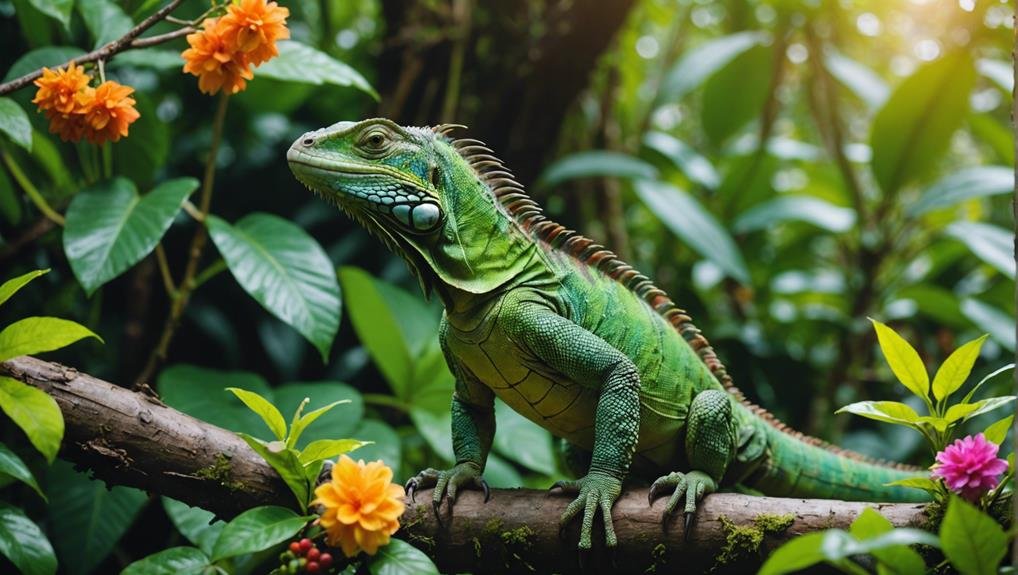When considering what to feed your iguana, you’ll find that dark green leafy vegetables should dominate their diet, but there’s more to it than greens. To ensure your iguana thrives, you must balance their intake with calcium-rich veggies and limited fruits, all while avoiding toxic foods. Do you know which vegetables and fruits are ideal and how to prevent common health issues? Understanding these details can significantly affect your iguana’s well-being, so let’s explore the intricacies of their dietary needs further. Learn more about What Do Iguanas Eat.
Key Takeaways
- Dark green leafy vegetables should comprise 80-90% of an iguana’s diet.
- Calcium-rich vegetables are essential to prevent metabolic bone disease.
- Fruits should be limited to less than 20% of total food intake.
- Avoid toxic foods like eggplant, avocado, sage, and rosemary.
- Calcium supplements and commercial iguana food can complement their diet.
Ideal Plant-Based Diet
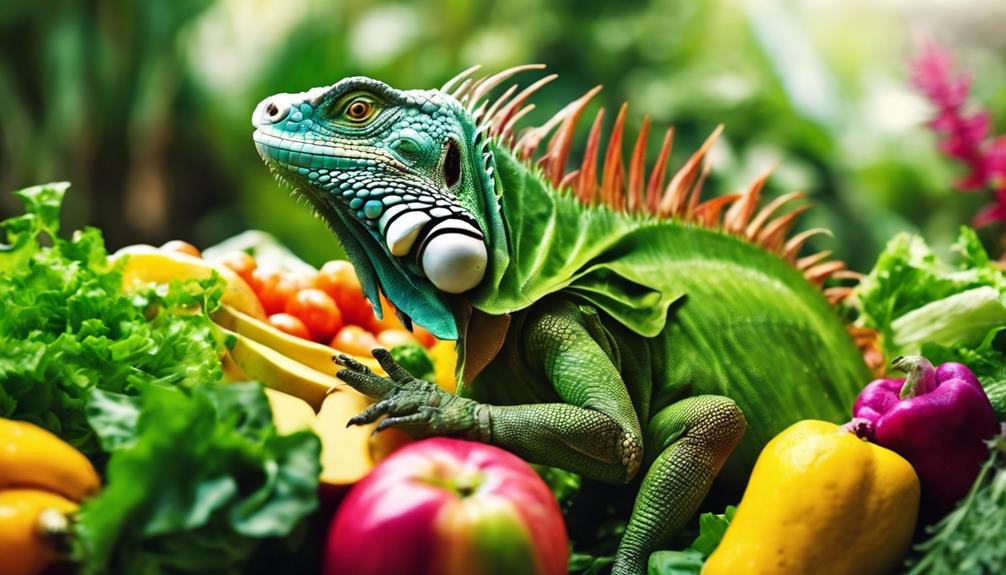

To guarantee your iguana thrives, provide a diet rich in dark green leafy vegetables. Iguanas need a plant-based diet to stay healthy, with 80-90% of their food intake coming from dark green leafy vegetables. These vegetables are packed with essential nutrients supporting their health and well-being. Including calcium-rich vegetables in their diet prevents metabolic bone disease, a common issue in iguanas caused by calcium deficiency.
While dark green leafy vegetables should make up the bulk of their diet, you can also include fruits, but they should constitute less than 20% of their total food intake. Fruits provide variety and additional vitamins but are less nutrient-dense than dark greens.
Incorporating a calcium supplement can ensure your iguana receives the necessary nutrients. You can also use commercial iguana food to supplement their fresh plant material, but it shouldn’t replace the primary diet of fresh vegetables. Avoid feeding them nutrient-deficient vegetables, like light green lettuce, which don’t offer the needed nutrients and can lead to health problems.
Foods to Avoid
While providing a balanced diet is important, knowing which foods to avoid for your iguana’s safety and health is equally vital. Some foods can be harmful or even toxic to your iguana, so you must be cautious about what you include in your diet. Here are three essential categories to keep in mind:
- Toxic Vegetables and Fruits: Avoid poisonous vegetables like eggplant and avocado, which can be dangerous for iguanas. Similarly, avoid poisonous fruits such as rhubarb.
- Toxic Herbs: Avoid feeding your iguana toxic herbs like sage and rosemary. These herbs can cause health issues and shouldn’t be a part of an iguana’s diet.
- Seeds from Fruits: Even if the fruit is safe, the seeds can be problematic. Limit seeds from fruits like apples and pears to prevent digestive issues.
Additionally, be cautious with kale and spinach. While they aren’t toxic, feeding them in excess can lead to health problems due to their calcium-binding properties. By knowing these foods to avoid, you can help ensure your iguana stays healthy and happy.
Feeding Frequency
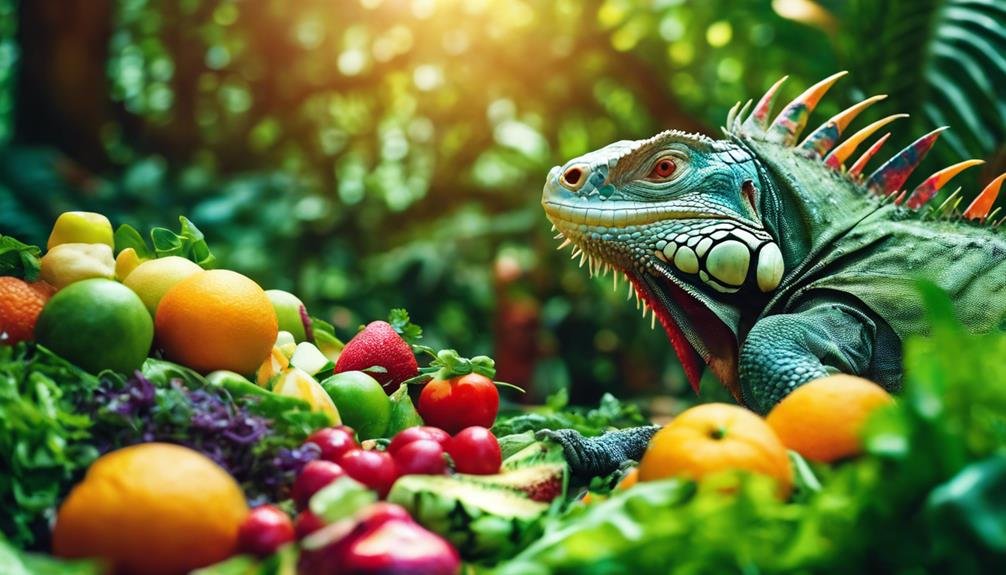

Understanding the appropriate feeding frequency for your iguana is essential for ensuring its peak health and well-being. Age and activity level play significant roles in feeding iguanas. Young iguanas need daily feeding to support their rapid growth and development. They require a consistent supply of nutrients to thrive, so don’t skip their meals.
How often I should feed adult iguanas depends on their activity level and weight. Typically, adult iguanas can be fed daily or every other day. If your iguana is particularly active, daily feeding will help maintain its energy levels. However, if your iguana is more sedentary or showing signs of being overweight, you might need to reduce the feeding frequency to every other day. This approach helps prevent obesity-related health problems.
Iguanas love their meals, but overfeeding can lead to health issues. Adjusting feeding frequency based on your iguana’s age, size, and health status is vital to ensure they get a balanced diet without overindulging.
Appetite Loss Causes
Appetite loss in iguanas can stem from inadequate tank temperature, poor humidity, or insufficient UVB exposure. These factors are critical in maintaining your iguana’s health and well-being. When these environmental conditions aren’t at their best, your iguana may stop eating, leading to further health complications.
Here are three common causes of appetite loss in iguanas:
- Temperature: Iguanas require a specific temperature range to digest their food properly. If the tank is too cold, their metabolism slows down, causing a lack of appetite.
- Humidity: Low humidity levels can lead to dehydration and digestive issues. Iguanas need a humid environment to thrive; they may refuse to eat without it.
- Parasites or illness: Parasites can wreak havoc on your iguana’s digestive system. If you notice a sudden loss of appetite with no apparent environmental cause, consulting a veterinarian for parasite treatment is essential.
Proper care and monitoring of your iguana’s tank conditions can help prevent appetite loss. Regularly check the temperature and humidity levels and ensure adequate UVB exposure. If you’re unsure of the cause, seeking a veterinarian’s advice can provide the necessary guidance.
Healthy Vs. Unhealthy Signs
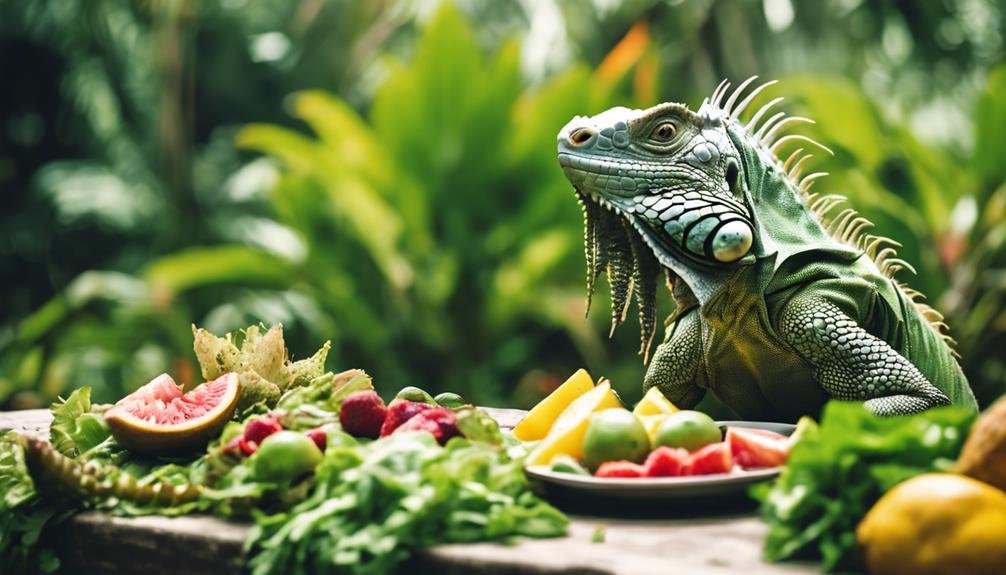

Recognizing the signs of a healthy iguana guarantees their overall well-being. A healthy iguana will have bright, clear eyes and a clean mouth without mucus or sores. These visual cues indicate that your iguana is flourishing. Additionally, ensure all the spikes on their back are intact, and there are no abnormal bends or kinks in their tail or limbs. It’s also essential to check that your iguana has five toes on each limb, with no missing nails, as this is another indicator of good health.
On the other hand, an unhealthy iguana may show signs that something is wrong. Dull, sunken eyes, and lethargy are clear red flags. Abnormal behaviors, such as a lack of appetite, shouldn’t be ignored. Regular health checks can help you spot e-signs early, allowing prompt intervention if your iguana is unwell.
Long-Term Care Tips
For the long-term care of your iguana, you’ll need to provide a spacious habitat with proper UVB lighting and temperature control. Iguanas require specific conditions to thrive, and neglecting these can lead to severe health issues. Here are three essential tips to guarantee your iguana’s well-being:
- Spacious Habitat: Iguanas grow large, so a roomy enclosure is essential. Aim for a habitat that allows for both horizontal and vertical movement.
- UVB Lighting and Temperature Regulation: Proper UVB lighting is critical for your iguana’s calcium metabolism and overall health. Ensure a temperature gradient is maintained in their enclosure, with basking spots reaching 95°F and cooler areas around 75°F.
- Balanced Diet: A well-balanced diet is necessary for your iguana’s long-term care. Offer a variety of leafy greens, vegetables, and fruits to ensure they get all the required nutrients.
Regular veterinary check-ups are also crucial. They help catch potential health issues early and keep your iguana in shape. Successful reptile care involves understanding your iguana’s needs and being consistent with their care routine. Your dedication will ensure a healthy, happy companion.
Additional Resources
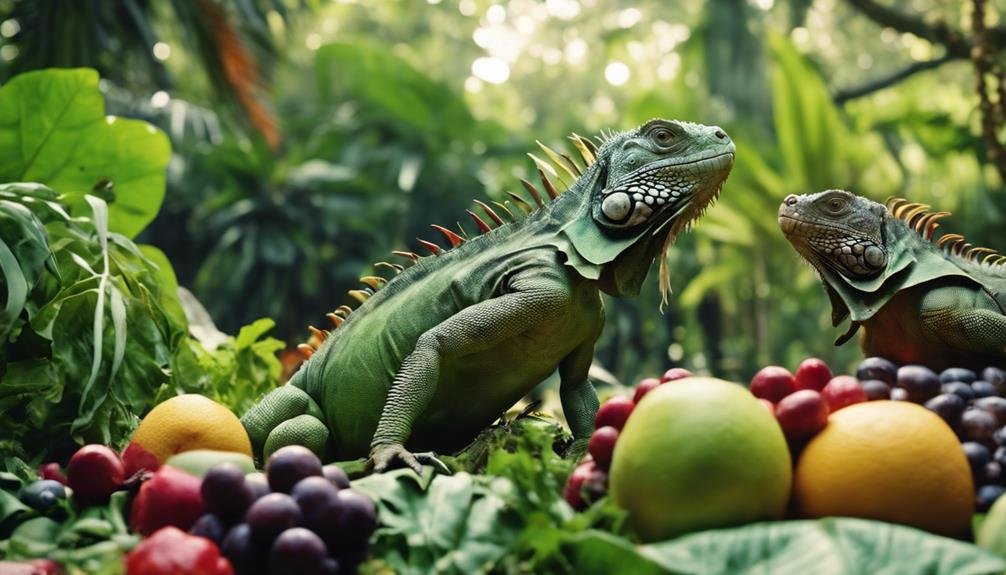

To further enhance your iguana care knowledge, explore these additional resources that provide in-depth information and expert advice. Websites like the Green Iguana Society and Reptile Magazine offer detailed guides for green and pet iguanas. They cover essential topics such as feeding, habitat setup, and health care.
One vital aspect of iguana care is ensuring a balanced diet. These resources emphasize the importance of providing a variety of fruits and vegetables. You’ll find lists of safe, nutrient-rich options to include in their diet, ensuring your iguanas receive the necessary vitamins and minerals. They also highlight the significance of vitamin D, which iguanas receive through exposure to UVB light, which is essential for calcium absorption.
Remember, feeding your iguana a diet rich in dark green leafy vegetables and calcium-rich produce is best when caring for your iguana. Avoid harmful foods like avocado and eggplant. These resources also offer advice on vitamin and mineral supplements to maintain your iguana’s health.
Conclusion
By following these guidelines, you’ll guarantee your iguana stays healthy and happy. Focus on providing a diet rich in dark green leafy vegetables, and remember to limit fruits and avoid toxic foods.
Monitor their feeding frequency and be alert to any signs of appetite loss or health issues. With balanced nutrition and proper care, your iguana will thrive for years.
For more detailed information, check out the additional resources provided.
Related Article:
https://thereptileguide.com/corn-snake-lifespan/
https://thereptileguide.com/guinea-pigs/

